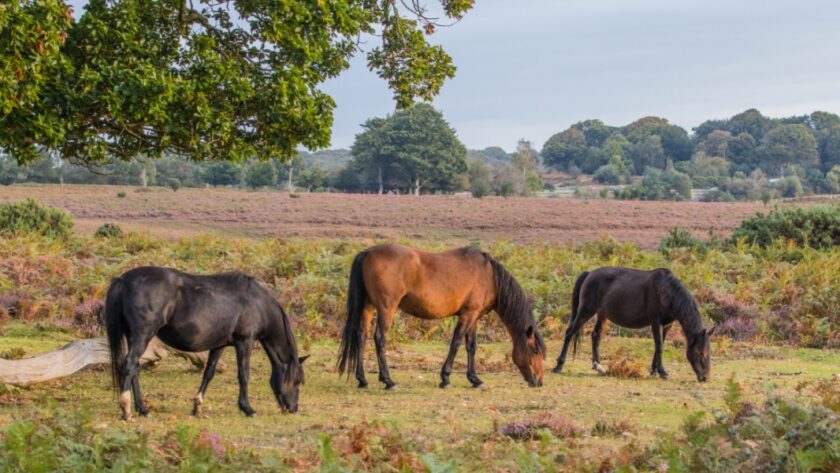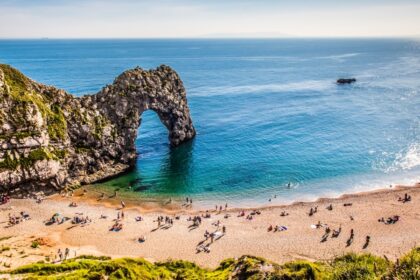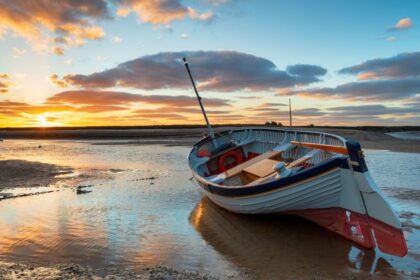There is something wonderfully contradictory about the New Forest. You might reasonably expect a forest to be full of densely packed trees and gloomy clearings, and at first glance you do see plenty of those. But wander off the well-trodden paths and you discover a landscape of rare breadth and light. Broad, open heathlands dotted with gnarled oaks and silver birches give the forest an almost parkland feel. Occasionally you stumble across a perfect lawn of grass cropped short by wandering ponies. Then there are patches of bog that look like they have been airlifted straight from a Scottish glen and streams that ripple through under canopies of green so lush you can hardly believe they are real.
Origins and history
Although it has an air of timelessness, the New Forest is surprisingly young as forests go. it’s creation dates back to 1079 when a rather acquisitive monarch, William the Conqueror, decided that what these parts really needed was a royal hunting ground. And so with a swift royal decree and probably more than a little grumbling from those who had farmed and foraged these lands for generations, the New Forest was born.
Despite it’s grand title it was hardly new even then, for this landscape of woods and bogs had been lived in and shaped by people long before the Normans set foot here. Bronze Age barrows and Iron Age hillforts lie scattered among the glades and even today the commoners who live here hold ancient rights to graze their animals and collect firewood. It is that gentle interplay of people and nature that has kept the New Forest so special for so long.
Wildlife and wanderings
More than anything else the New Forest is famous for it’s animals. None are more celebrated than the New Forest ponies, who have roamed freely for centuries. They amble along lanes with a charming sense of entitlement and seem to view passing cars as little more than moving inconveniences. Deer slip silently through the undergrowth at dusk and, if you are lucky, you might catch a flash of a Dartford warbler on the heath or a stag silhouetted against the setting sun.
Exploring is best done at a slow pace. The forest is criss-crossed with gentle trails for walkers and cyclists and every so often you will come across a rustic tea shop tucked into a hamlet. Perhaps it is the sense of seclusion that draws people back. Even when visitors are at their busiest you can wander a short way and feel as though you have the whole forest to yourself.
Places to visit in The New Forest
If you want to make a day of it, Lyndhurst is often considered the forest capital. It has it’s fair share of bustling shops and a helpful visitor centre where you can pick up maps and advice. From there you can head deeper into the forest to admire some of it’s most famous sights. Beaulieu is home to a splendid abbey and a motor museum that will delight anyone who appreciates vintage cars. Buckler’s Hard, on the Beaulieu River, feels like stepping straight into the past with it’s neat Georgian cottages and former workshops.
Brockenhurst lies right at the heart of the forest and feels like a gateway to its wild beauty. Ponies often wander its leafy lanes, and gentle trails fan out into the woods, making it a perfect base for exploring the New Forest.
And then there is Burley, where legend tells of smugglers and witches. Wander into any one of it’s pubs and you will probably come across someone who can spin you a tale about white witches who once walked the forest paths. Even if you don’t believe a word of it, there is a pleasure in the telling.
A forest for all seasons
One of the enduring pleasures of the New Forest is it’s ability to change with the seasons. In spring the woodlands erupt in bluebells and the air hums with birdsong. Summer brings warm days perfect for picnics under ancient oaks. Autumn paints the forest in a glorious array of golds and browns as deer begin their rutting and the morning mists hang heavy. Winter is hushed and crisp and the forest takes on a different kind of beauty.
Perhaps that is the real charm of this forest. It is forever shifting and forever itself. Every visit feels like stepping into an old friend’s garden, familiar and surprising all at once.
Useful Information
Location
The New Forest lies mostly within Hampshire and stretches into south Wiltshire. The nearest towns are Lyndhurst, Brockenhurst and Lymington.
Getting There
Easily reached by car via the M27 or by train with stations at Brockenhurst, Ashurst and Beaulieu Road.
When to Visit
All year round. Spring for bluebells, summer for long walks and picnics, autumn for golden foliage and deer rutting, winter for misty morning strolls.
What to See and Do
• Wander the forest trails on foot or by bike
• Look out for wild New Forest ponies
• Explore Beaulieu Abbey and Buckler’s Hard village
• Stop for tea and cake in Burley or Lyndhurst
• Visit the New Forest Wildlife Park
Useful Links
New Forest National Park – visitor info, maps and guided walks





